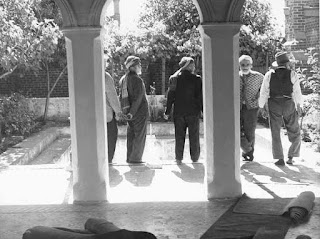Binaural Beats
There are many unexplained phenomena in paranormal and
spiritual study. One such phenomenon, “Binaural Beats” has been investigated
thoroughly by the CIA and the Monroe Institute, (amongst other credible
researchers).
There have been claims this phenomenon can be used to
improve people’s moods, help people with learning difficulties to concentrate,
and even claims it can lead to different states of consciousness, much like the
use of drugs LSD.
Further claims suggest that spiritual enlightenment can be obtained through the use of binaural beats, Astral Travel, Chakra Stimulation, Chi energy, Lucid Dreaming and telepathy are all claimed to be gained, at least temporarily, through the listening of certain “tones.
Further claims suggest that spiritual enlightenment can be obtained through the use of binaural beats, Astral Travel, Chakra Stimulation, Chi energy, Lucid Dreaming and telepathy are all claimed to be gained, at least temporarily, through the listening of certain “tones.
So, what are Binaural Beats?
German experimenter, H.W. Dove first discovered binaural
beats in 1839.
Two tones (sound
waves) that are very close in frequency (but not exactly the same), are played
separately into each ear (one tone in the left ear, the other separately in the
right ear). The resulting effect the listener hears is a single tone that
varies in amplitude, but is equal to the frequency difference between the two
original tones.
Through various studies, it has been claimed that binaural beats influence on electrical stimulation within the brain. Studies via EEG have shown that the effect may affect states of consciousness.
Various studies have claimed that binaural beats can be used
to stop migraines, boost creativity, help prolong concentration and alter the mood.
The effect has also been dubbed a “digital drug” as some scientist claim
similar effects to hallucinogens can be obtained in some people, using the
right tones.
There are claims that
the CIA studies into binaural beats were aimed at mind control techniques. Some
conspiracy theory claimants believe that binaural beats are subliminally hidden
in modern music, and with today wave of headphone-wearing young people, they
are unwittingly being led consumerism through the hidden tones.
On the opposite side
of the argument, sceptics point to the power of suggestion as one cause of the
claimed brain activity cited by the Monroe Institute. A Japanese study found
great variabilities in results, and concluded, that, although the cerebral
cortex may contain more activity whilst listening, the frequency does probably
not cause the brain activity itself. (Journal of Neurophysiology 2006)
Whether Binaural Beats can do what it is claimed, some ghost
hunting teams are beginning to use the phenomena to help with their ghost
hunting investigations. They begin with a meditative session of Binaural Beats
to help “open their senses” before entering the location, in the hope that the
frequency attunement will lend to gathering paranormal evidence.
While there is no real reason the “beats” will help bring about paranormal evidence, it most certainly can induce an internal environment that leads to “personal experience”, and for some, personal experience is becoming more important than the collection of possible paranormal phenomena and that’s ok.
So ghost hunters looking to try something different, why not
give it a go and see what happens, and if you do have an experience that you
feel is significant, head to the “Eidolon Paranormal” Facebook page and tell us
about it!
Further
reading from the Monroe Institute:
Accessing Anomalous States of Consciousness with a Binaural
Beat Technology https://www.monroeinstitute.org/article/3001
Using Binaural Beats to Enhance Attention
Binaural Auditory Beats Affect Vigilance Performance &
Mood
Binaural Beats Examples: http://healingbeats.com/play.html
Binaural Beats experiences (forum): http://www.diydharma.org/keywords/binaural-beats
Bibliography
Binaural Auditory Beats Affect Vigilance Performance &
Mood | The Monroe Institute. 2017. Binaural Auditory Beats
Affect Vigilance Performance & Mood | The Monroe Institute.
[ONLINE] Available at: https://www.monroeinstitute.org/article/2664.
[Accessed 02 March 2017].
Dunning B, 2009, Binaural beats digital drugs, Skeptoid Critical
Analysis of Pop Phenomena, viewed 2 March 2017, https://skeptoid.com/episodes/4147
Free Binaural beats: This is your brain on binaural beats -
sound meditation. 2017. Free Binaural beats: This is
your brain on binaural beats - sound meditation. [ONLINE] Available
at: http://www.noiseaddicts.com/2008/09/this-is-your-brain-on-binaural-beats/.
[Accessed 02 March 2017].
Karino S & Yumoto M & Itoh K & Uno A &
Yamakawa K & Sekimoto S & Kaga K, 2006, Neuromagnetic responses to binaural beat in human cerebral cortex,
Journal of Neurophysiology, viewed 2 March 2017, https://www.ncbi.nlm.nih.gov/pubmed/16790592?ordinalpos=8&itool=EntrezSystem2.PEntrez.Pubmed.Pubmed_ResultsPanel.Pubmed_DefaultReportPanel.Pubmed_RVDocSum
Reedjik, SA & Bolders, A & Hommel, B, 2013, The impact of binaural beats on creativity,
Frontiers in Human Neuroscience,
viewed 2 Mar 2017, https://www.ncbi.nlm.nih.gov/pmc/articles/PMC3827550/









